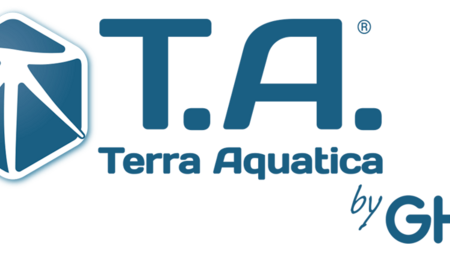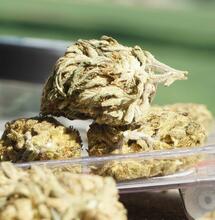The history of GHE and its mutation in Terra Aquatica.
17 Dec 2018

William Texier and Noucetta Kehdi
In 1973 they met in a hippy neighborhood in Liege, in the eighties, in California, they fortified their relationship. They spent a lifetime fighting against the hypocritical prohibition that tried to relegate hemp to the margins of modern history. They exposed themselves, with concrete activism, propaganda and frontline actions: growers and developers of hydroponic systems, they brought into the cannabis sector eco-friendly products and an attitude of pragmatism and sweetness, as well as a libertarian spirit against profit aimed at itself. If you know a little about the history of the international cannabis movement and the French one, you will have recognized. the portraits of William Texier and Noucetta Kehdi, with whom today we have the great pleasure of sharing the past and to delve together into the challenges of the years to come. SSUK: How and when did you meet? William: I have known Noucetta since the early 1970s. We met in Liege during our "hippy years" I was part of a large group of non-conformists who all lived on the same street and Noucetta was a science student in politic science. Noucetta: William and I have known each other for almost 50 years. That was in 1973, in Belgium. At the time I was studying in Brussels, but I spent most of my time in Liège. We were "hippies" who lived in Roture, in the "cage of lions", as the Liège inhabitants of Outremeuse called it, a place where we were in a kind of open community, where friendships were forged to last, roads crossed and uncrossed at the rhythm of each other’s journeys.The American period
SSUK: After Belgium, you went to California where you lived for years and worked on the development of GH in the United States. Tell us a few moments of this productive but difficult period.... William: At the time, I was already working with GH US doing tests to better adapt Flora Series to cannabis, and I was also making the AeroFlos that I had designed with Larry Brooke, the founder of GH. Noucetta came to join me in Santa Rosa, California in 1989. However, she did not choose the best of times, because I was growing cannabis commercially and I was arrested 3 weeks after the arrival of Noucetta. She saved me by taking care of the children (my daughter and her son) and my work with GH US during my 14 months in prison. Larry was also a great friend because he continued to pay Noucetta the same salary as when we both worked, and that during the whole time I was in prison. Together Noucetta and Larry took care of the outside, I just had to manage my life inside, not always easy. A humorous note that does not make me laugh too much: the prison in which I was locked up was bought by Ziggy Marley to grow grass there. Fate sometimes has a strange sense of humor. Noucetta: It wasn't until 1989 that I found William for good. He lived in California and I went to meet him for a 15-day vacation. But life had decided otherwise: we never left each other. At that time William was a grower and had discovered hydroponics through his friend Lawrence Brooke, who founded General Hydroponics in 1975 in Berkeley. Together with Cal Herrmann, head of the water purification department at NASA, they were all passionate about culture and science, and created Flora Series, the AquaFarms, and the first AeroFlos, now known and distributed worldwide. But William, who tested these products and was involved in their design, was arrested for cannabis cultivation at the very beginning of the famous "Green merchant" operation, in September 1989. I, who spent a few days of vacation at his house, was also behind bars, but only for 3 weeks. Then began a period that, between trial and prison, lasted 5 years during which William remained in prison for many months, and I, at home with two children.
Noucetta: It wasn't until 1989 that I found William for good. He lived in California and I went to meet him for a 15-day vacation. But life had decided otherwise: we never left each other. At that time William was a grower and had discovered hydroponics through his friend Lawrence Brooke, who founded General Hydroponics in 1975 in Berkeley. Together with Cal Herrmann, head of the water purification department at NASA, they were all passionate about culture and science, and created Flora Series, the AquaFarms, and the first AeroFlos, now known and distributed worldwide. But William, who tested these products and was involved in their design, was arrested for cannabis cultivation at the very beginning of the famous "Green merchant" operation, in September 1989. I, who spent a few days of vacation at his house, was also behind bars, but only for 3 weeks. Then began a period that, between trial and prison, lasted 5 years during which William remained in prison for many months, and I, at home with two children.
Hydroponics
SSUK: What role did hydroponics play in this period of your life? Noucetta: At the time especially, hydroponics was a cutting-edge technology, opening up enormous horizons: growing healthy, nutritious and vigorous plants, using very little space, very little water, with a yield more than 30% higher than the same soil crop. The conversion was immediate. So, in a few months (before William found himself in Saint Quentin) we set up a food production greenhouse in Sebastopol, California, which we called "The White Owl WaterFarm". We produced peppers, basil, tomatoes, etc... that I sold at local farmers' markets and at high-end restaurants in San Francisco Bay, especially the famous Chez Panisse in Berkeley. At the same time, I was working at GH building AeroFlos. Both activities allowed me to stay the course and continue to offer our kids a pleasant life free of need. Until William's return, then his deportation and our forced return to France. That was in December 1994.
The return to Europe and the birth of GHE
SSUK: After your return to Europe, how did GHE come into being? William: GHE started in 1995. After this episode of visiting California prisons, I was deported by emigration. Our friend Larry's mantra was "revenge through success". That's how it was decided to create a European branch of GH, to give an income to Noucetta and I who were returning to Europe with nothing, the costs of lawyers and fines having consumed all our money and our house. GH US was in full expansion, with incredible growth. They had difficulty providing their market and they did not really believe in an external one. That's why we came here with few resources. The great gift that was given to us was all the GH formulas, plus the name and image: it was then up to us to make this heritage grow. In fact, GHE was born out of my arrest in the fall of 1989 and the need to start our lives over. Noucetta: We were going home impoverished! 14,000$, a house in the country in the Southwest and two teenagers. But it was once again without taking into account our determination and the friendship of Lawrence and Cal. It was obvious to them, as it was to us, that we would continue the hydroponic adventure in Europe. We created GHE in August 1995 in Fleurance , Gers. The first fertilizers were made in our laundry room in a 200L barrel, and our children stuck the labels of our first Flora Series. In a few years GHE has gained its place on the European market from a small company of 2 people to more than 30 people today.GHE and the ecological challenge
SSUK: The challenge won in the past was to combine technology and respect for nature. How can we look to the future with the same perspectives? William: The world has changed a lot since I started working with GH around 1986. At the time we only used mineral fertilizers and no additives, neither natural nor synthetic. Respect for nature came mainly from the fact that our mineral fertilizers are used in homeopathic doses and are contained in tubes or pots. Under no circumstances can they pollute the soil or groundwater, so it is an environmentally friendly way of growing. Since then, I have worked hard to introduce organic products into our cultivations. That's been my line of thought for the last 10 years. The first step in this direction was the formulation of G.O. Sevia, an organic fertilizer that can be used in organic agriculture and that works in hydro. We have patented the technology under the name "Bioponie" (patent # 05.11569 of 15.11.2005). Then came the creation of a line of organic supplements, all of which can be used in organic agriculture. This introduced a large amount of organic matter into hydroponics and began to bring hydroponics cultures closer to the conditions in which plants live in nature. The next step was the introduction of life into our systems. It started with trichoderma, a beneficial fungus that protects roots in hot weather, but has also many other benefits; then we introduced bacteria to further strengthen the root’s defense effect. Currently, I am working on the introduction of even more microorganisms, possibly on the leaves themselves, always with the idea of introducing more and more living organisms into our cultures to get closer to nature. Just because our plants grow in plastic tubes or pots does not mean that we cannot create "natural" agriculture.
The acquisition of GH US by Scotts Miracle- Gro and the birth of "Terra Aquatica"
SSUK: In 2014 GH US was acquired by Scotts Miracle-gro, an American company? What difference does it make to GHE? William: It changes everything. We were not acquired by Scotts for various reasons, mainly the size of the European market compared to the US, but also the legislation in the different European countries. Scotts gave us a five-year license to close the company or change its name. I cannot close because I do not want to put a team of about thirty people out of work, some of whom have been with us since the beginning. So, we will have to change our identity, a huge task because we will have to communicate country by country, probably losing market share during this process, but I have to ensure a future for my team. We have three years left to make this change and from the end of the year, you will start to see two product names on our labels, as well as two logos. Our term company will be called "Terra Aquatica", an identity under which we will continue to manufacture and sell our current range, but also more products for soil cultivation. SSUK:What are you planning to do to preserve your independence and identity? William: The cannabis industry in the US is now largely in Scotts' hands. You can't grow your plants without buying at least one product from a brand they control. All these years of activism and suffering for many people for the industry to end up in the hands of multinationals! This is a situation I find very difficult to tolerate. How will we survive when Scotts becomes our competitor and sells GH in Europe? It's a challenge and I'm not sure that we will win it. It is necessary to communicate, and still communicate, to explain to customers that they can obtain the same products either from a large group with a questionable mentality, or from Terra Aquatica, which remains a family business with the same values. I am naturally optimistic, and I hope that people will follow us. It is not just about GHE; we must not reach the same situation in Europe as in the United States. Our profession must remain in the hands of independent companies. Noucetta: Phew! It was close! We didn't want this sale, let alone this association with a multinational company whose value we didn't share! Scotts Miracle-Gro is a money factory, in all circumstances. All they look at are the day-to-day profits, their stock market listing and the approval of their shareholders. They bought GH in California with the primary intention of keeping the teams intact and benefiting from its know-how and vision. In less than 5 years they managed to dismiss some of the staff and disgust another party who eventually resigned. They have also recently purchased Botanicare, Canfilter, Gavita, and Sunlight Supplies to ensure control of this market. In the long term, the name GHE will disappear, but we remain the owners of all our products and formulas, we are the experts in our specialty: hydroponics, and plant nutrition. And we know well our market and its needs. We have already started our conversion, and soon you will see the name of our new company, Terra Aquatica, on our labels. We will offer our usual product line under new names, and we will add new products for both hydroponics and soil. We already have some new products in our pipes, and we are preparing others that will pleasantly surprise you.GHE's family
 SSUK: Who usually works with your products? What are they looking for? What do you offer them?
Noucetta: There is everything. Small growers as well as large ones, young people as well as older ones, wherever possible and where the law allows it or tolerates it.
There are also newcomers, urban farmers, family hydroponic food production farms, aquaponists, CBD farmers now that CBD is legalized in some countries.
Our customers are looking for efficient products and a trusted company that offers them an innovative and sustainable vision. And that's exactly what we bring. It is true that the younger generations know us a little less, and it is to them that we would like to address ourselves: our company exists since 1975, but that does not mean that we are old and decayed! Our oldest researchers have more than 40 years of experience and knowledge (and still 20 years in their hearts!) and the young people who join them add their vision of a new world, where there is still much to do. We offer our clients an extraordinary level of expertise and an innovative perspective with which they can grow with their eyes closed. We also offer them ethics and seriousness without which a company cannot last in time and a clientele cannot project itself.
SSUK:What is your pride and what are the challenges for the future?
William: My first pride, which is also a surprise, is to still be alive with the adventurous life I have led! More seriously, I am quite happy to have been among the first to explore organic hydroponics and to have created Biopony. I am self-taught, but I often share the podium with scientists at seminars and have accumulated a lifetime of experience in my field.
In another respect, I am particularly proud to have provided cannabis growers with the tools they need. General Hydroponics was the pioneer in the United States of indoor culture. Suddenly, consumers no longer needed to use the black market and could grow their own consumption. I often joke that we have put more drug dealers out of work than any cop, but it's not just a joke. A recent anecdote: a few months ago, I was shopping with Larry Brooke in a grow shop in northern California. When one of the salesmen learned that Larry is the founder of GH, he came to him and said, "Thank you, thanks to you I have been able to feed my family all these years. That's is GH (that was!), and I'm damn proud to have participated.
SSUK: Do you want to share a message with those who have always supported you and those who are now starting to know you?
William: We only exist because of a core of loyal customers, both stores and a large number of users, and of course I thank them for their loyalty. The future of our industry presents a challenge: we must avoid the North American situation, and the takeover of our industry by groups that represent everything we hate, and that have the greatest contempt for cannabis smokers. You will have to be careful in the coming years and know who your money goes to when you buy equipment.
Noucetta: I thank from the bottom of my heart all the farmers who have remained loyal to us despite the sale of GH. I also thank all the resellers, retail stores and distributors who continued to believe in us. There was a moment of hesitation for those who thought we were associated with the big multinational industry. We had to fight and communicate so that the information about our independence would get past the "hearsay" and amalgams! But here we are, today we have kept the majority of our traditional customers. For those who remain distant, I hope they will find us again thanks to this message and the one from the other media that allowed us to express ourselves. For newcomers, please come and test our product range. Traditional or new, they are all designed for their impeccability and efficiency. To all our current and future customers, I ask you to be aware of our name change. If in a few months you discover a brand called Terra Aquatica, know that it is a metamorphosis of GHE, so that our company can remain independent from the influence of the big industry, proud of our vision and ethics and faithful to our life mission.
SSUK: Who usually works with your products? What are they looking for? What do you offer them?
Noucetta: There is everything. Small growers as well as large ones, young people as well as older ones, wherever possible and where the law allows it or tolerates it.
There are also newcomers, urban farmers, family hydroponic food production farms, aquaponists, CBD farmers now that CBD is legalized in some countries.
Our customers are looking for efficient products and a trusted company that offers them an innovative and sustainable vision. And that's exactly what we bring. It is true that the younger generations know us a little less, and it is to them that we would like to address ourselves: our company exists since 1975, but that does not mean that we are old and decayed! Our oldest researchers have more than 40 years of experience and knowledge (and still 20 years in their hearts!) and the young people who join them add their vision of a new world, where there is still much to do. We offer our clients an extraordinary level of expertise and an innovative perspective with which they can grow with their eyes closed. We also offer them ethics and seriousness without which a company cannot last in time and a clientele cannot project itself.
SSUK:What is your pride and what are the challenges for the future?
William: My first pride, which is also a surprise, is to still be alive with the adventurous life I have led! More seriously, I am quite happy to have been among the first to explore organic hydroponics and to have created Biopony. I am self-taught, but I often share the podium with scientists at seminars and have accumulated a lifetime of experience in my field.
In another respect, I am particularly proud to have provided cannabis growers with the tools they need. General Hydroponics was the pioneer in the United States of indoor culture. Suddenly, consumers no longer needed to use the black market and could grow their own consumption. I often joke that we have put more drug dealers out of work than any cop, but it's not just a joke. A recent anecdote: a few months ago, I was shopping with Larry Brooke in a grow shop in northern California. When one of the salesmen learned that Larry is the founder of GH, he came to him and said, "Thank you, thanks to you I have been able to feed my family all these years. That's is GH (that was!), and I'm damn proud to have participated.
SSUK: Do you want to share a message with those who have always supported you and those who are now starting to know you?
William: We only exist because of a core of loyal customers, both stores and a large number of users, and of course I thank them for their loyalty. The future of our industry presents a challenge: we must avoid the North American situation, and the takeover of our industry by groups that represent everything we hate, and that have the greatest contempt for cannabis smokers. You will have to be careful in the coming years and know who your money goes to when you buy equipment.
Noucetta: I thank from the bottom of my heart all the farmers who have remained loyal to us despite the sale of GH. I also thank all the resellers, retail stores and distributors who continued to believe in us. There was a moment of hesitation for those who thought we were associated with the big multinational industry. We had to fight and communicate so that the information about our independence would get past the "hearsay" and amalgams! But here we are, today we have kept the majority of our traditional customers. For those who remain distant, I hope they will find us again thanks to this message and the one from the other media that allowed us to express ourselves. For newcomers, please come and test our product range. Traditional or new, they are all designed for their impeccability and efficiency. To all our current and future customers, I ask you to be aware of our name change. If in a few months you discover a brand called Terra Aquatica, know that it is a metamorphosis of GHE, so that our company can remain independent from the influence of the big industry, proud of our vision and ethics and faithful to our life mission.




